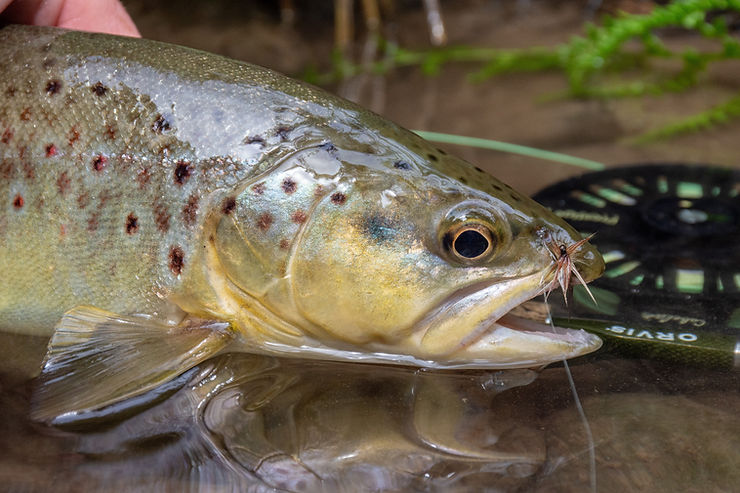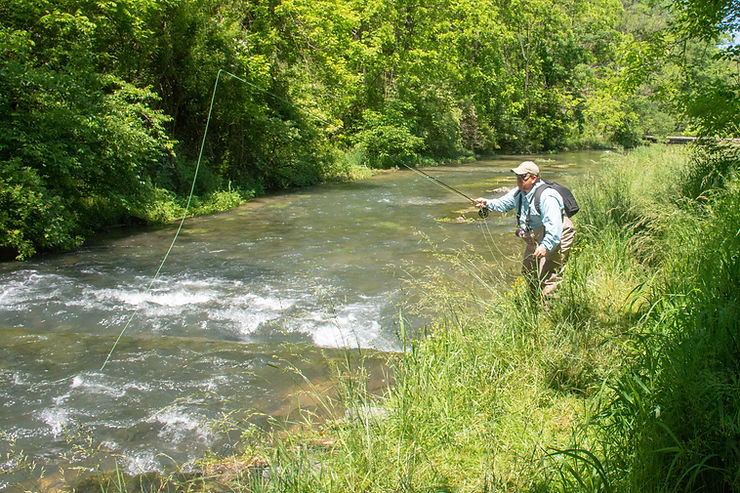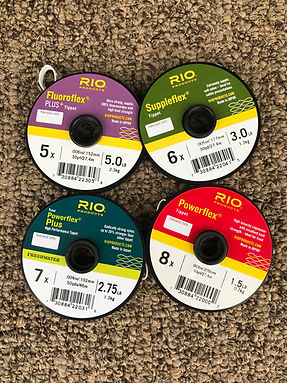Dry Fly Fishing Tips: 3 Considerations for Drag-Free Drifts

Drag kills. Drag can ruin a perfectly fine presentation and mean the difference between a catch and a refusal. The worst part of it is that sometimes you don’t even realize it’s happening.
We’ve all been there. We know what’s hatching, we know what the trout are keying on, and we even have the perfect fly for the job. And yet the fly gets snubbed. The drift looks fine to us, so we assume that the trout are probably feeding on something we’re not seeing. Truth is, our hatch-matching skills are just fine, but we’re not getting a natural drift.
Every stream is made up of thousands of currents and microcurrents, each one tugging your line in various directions. Some of these can be so subtle that, to the naked eye, you might not even realize their impact. The more you can minimize these seen and unseen elements that make up the water column, the more success you’ll have with both nymph and dry fly presentations.
In fact, one of the reasons that Euro-nymphing is so popular right now, and why it’s so effective, is that the associated equipment and tactics are designed to reduce drag. With Euro-nymphing, you get a more natural drift that results in more strikes. And incorporating many of those same Euro-nymphing elements into your dry fly fishing can cause your success rates to go up, too.
A Longer Rod, A Longer Reach
Once I finally broke down and bought my first Euro-nymphing rod, a 10-foot 3-weight TFO, it quickly became my favorite setup. I’ve used it for all types of fishing, from nymphs to small streamers to dry flies. I think many fly fishermen overlook how delicately and accurately a Euro-style rod can deliver a dry fly. The rod’s action is perfect for soft presentations, and its longer length allows you to reach and catch fish that you had no chance at with, say, a 7 1/2 -footer.

(Photo: The more line you can keep up off the water, the less impact various currents will have on your drift.)
Also, with the longer rod, you can keep your line up off of the water for a greater distance. Every inch of line not on the water will increase the quality of your drift. I really noticed this on Spring Creek last week. I was fishing a spot where the stream had split and then come back together again, so there were essentially two main currents flowing at different speeds, and trout were rising for them more often in the one farthest from me. Not a problem. The longer rod allowed me to cast and keep my line up out of the near current so that I could get a drag-free drift on the other. I couldn’t have done that with a shorter rod.
Recently, I viewed an Orvis fly fishing video on You Tube featuring Tom Rosenbauer and George Daniel, and they were discussing Euro-nymphing techniques and equipment. Something Daniel said caught my attention. Basically, he said that a friend of his did the math and one foot of rod length translates into three more feet of reach. That means that using a rod even one foot longer can help you reach your line over three feet worth of tricky currents.
If we apply that same concept into any dry fly fishing scenario, imagine the benefits! Talk about a game changer.
Leaders and Tippets
Another way to reduce drag on your dry fly drifts is to lengthen your leaders and tippets. The more fly line you can keep up off of the water, the more natural drift you can achieve. Extremely long, supple leaders used for Euro-nymphing can also be used for dry fly fishing, but they’re difficult to cast because they are so light. You need at least a little bit of your fly line outside of the rod’s guides to help “load” the road to deliver a practically weightless dry fly.
For the actual tippet, I always use one as light as I can get away with, which means for most streams I’m using 6x-7x, with a strong preference for 7x, and in some situations 8x. The diameter difference between tippets isn’t extreme. Sizes generally range as follows (keep in mind, though, that there are sometimes differences between brands and/or materials as far as actual breaking strength):

8x .003” 1.75 pound test Fly sizes 22-28
7x .004” 2.5 pound test Fly sizes 18-24
6x .005” 3.5 pound test Fly sizes 16-22
5x .006” 4.75 pound test Fly sizes 14-18
One-thousandth of an inch doesn’t seem like much, so to better understand the difference, try removing the decimal point and the zeroes from the above numbers. The chart would then look like this:
8x 3 inches
7x 4 inches
6x 5 inches
5x 6 inches
In other words, 7x tippet is 33% larger in diameter than 8x, and 6x tippet is 25% larger diameter than 7x. Whether you look at it in terms of thousandths or in terms of inches doesn’t matter. The difference is greatest when dealing with smaller sizes.
Another way to interpret this chart is to say that 8x tippet has 33% less drag than 7x, and 7x has 25% less drag than 6x. In the world of trout, that’s a huge difference!
Euro-nymphing rods possess a distinct advantage in fishing these lighter tippets, too. They generally have medium-fast or medium actions that are much more forgiving on the hookset. They provide a “softer” buffer between you and the fly. And I’ve found that if I lengthen my 7x or 8x tippet to 3 or 4 feet (sometimes longer), I rarely break off or lose a fish to a snapped line.
One final note about this, though. When using 7x or 8x tippet in conjunction with flies larger than size 16, a strong knot is crucial. I prefer a Palomar knot, and I retie it after every couple catches or 20-30 minutes of fishing because you’re basically using a fly that’s too big for the tippet, which means more friction between the tippet material and the eye of the hook. The above chart shows the “ideal” fly size for each tippet size. If I’m varying too much from this general rule of thumb, I take the extra precaution and retie more often.

(Photo: On a drag-free drift, you’ll find no “ripples” or disturbances around your fly. The fly will float perfectly calm on the water’s surface.)
The Right Cast
How you deliver the fly is important. What rod, leader, or tippet you use doesn’t matter if you can’t present it all in a manner that doesn’t spook fish. Also, those currents and microcurrents start working against you as soon as the setup hits the water, and if you don’t which cast to pull from your “toolbox”, then drag will defeat you before the fly even gets to the trout. Here are a handful of casts that help me achieve better drag-free drifts:
The Reach Cast. I probably use this one most because it’s the easiest. Basically, as my fly line and leader turn over on the forward cast, and as they are falling to the water’s surface, I reach the rod upstream to get as much line as possible upstream of the fly before it even hits the water. This allows the fly to begin its drift with no tension, no drag.
The Wiggle Cast. For this cast, as the fly and leader unfurl on the forward cast, wiggle your rod back and forth to shake out extra line so that you basically end up with a bunch of slack line on the water. As your fly drifts, the line will uncurl and straighten to compensate for the various currents.
The Parachute Cast. This cast is achieved by aiming your fly and line higher than usual above the water. I always look at it like I’m trying to throw it into the trees. (Note: this cast doesn’t work if there are actually trees hanging over the stream above where you want your fly to land.) In essence, the line, leader, and fly are all turned over on the forward cast several feet above the water, and then they gently drop down. However, once they’ve unfurled completely, there’s a slight “recoil” in the line which causes the setup to contract and you end up with more slack in your presentation.
Casting is difficult to teach on a page without extensive diagrams. In-person instruction or videos are truly the best way to learn casting techniques. You can even find some great demonstrations on You Tube just by searching the name of the particular cast you want to learn.
Finally, mend, mend, mend. Occasionally I get creative and can work a little bit of a Parachute Cast into my Reach Cast, which affords me a little more leeway right from the start, but more often than not, to maintain that drag-free drift, I have to continuously mend the line. With mending, you’re basically throwing loops of line upstream to offset the effects of the current closest to you. You can find numerous videos about mending online, too.
Conclusions
There are many other ways to achieve drag-free drifts. These are just a handful of methods that work for me. As with anything, the only way to get better is through lots of practice and lots of on-the-water experience.
Eventually you build muscle memory and instinct takes over. You find that you’re doing everything right without even thinking about it. And in those moments, you stop focusing on the technical aspects of the rod, leaders, tippets, and casting, and instead get totally immersed in the moment the fly drifts into the trout’s feeding window, and you see the rise and set the hook.
Fish on!
Sign up for the Dark Skies Fly Fishing e-newsletter
It's free, delivered to your inbox approximately three times each month. Your information is always kept private and used for the sole purpose of keeping you up to date on blog posts and specials in the online store.
Sign Up Now
Build your leaders.
That can definitely help. This is one of the reasons why we offer custom, hand-tied dry fly leaders in our online store. They provide better options for fishing dry flies more effectively than most machine tapered leaders. They allow you to throw more s-curves into the leader, which gives you a better, drag-free drift.
Thank you for reading!
Here’s a link to the leaders in our online store for anyone interested: https://darkskiesflyfishing.com/product-page/leader-dry-fly-leader-custom-hand-tied/
We also have the George Harvey Improved Dry Fly Leader: https://darkskiesflyfishing.com/product-page/leader-george-harvey-dry-fly-leader/